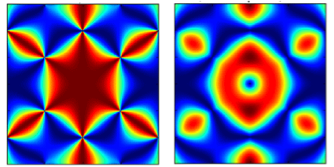Artificial Light in a Quantum Spin Ice
Real magnetic monopoles remain a theoretical curiosity, but researchers have found that excitations in materials called spin ices behave like analog monopoles, obeying an effective Coulomb’s law for magnetic charges. In Physical Review B, Owen Benton and his colleagues at the University of Bristol, UK, ask what “photons,” which emerge in the quantum version of a spin ice, would look like in an experiment.
The most common spin ices have a structure consisting of corner sharing tetrahedra, with a spin at each corner. The spins are “frustrated,” meaning they can’t align in such a way that satisfies the interactions with all their neighbors, so they compromise and form a structure with two spins pointing into each tetrahedron and two pointing out (a configuration analogous to the ordering of hydrogen bonds in water ice.) In a spin ice, flipping an inward pointing spin to an outward one is analogous to exciting a monopole-antimonopole pair in adjacent tetrahedra.
Theorists have posited that strong quantum fluctuations in ice structures would allow one configuration to transition into another, creating a superposition of classical states called a quantum spin ice that can be described (mathematically) by a kind of quantum electrodynamics with magnetic monopoles.
Benton et al. have now translated this highly mathematical theory into a prediction for how neutrons, the probe of choice for studying magnets, scatter from a quantum spin ice. They show that the signature for classical spin ices, called “pinch points,” disappear in the quantum spin ice. Similarly, excitations around these points mimic “photons” in the artificial electromagnetic field. – Jessica Thomas





